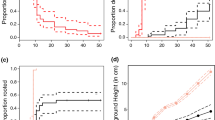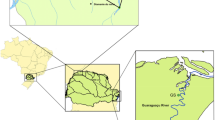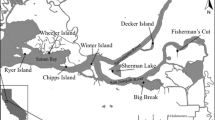Abstract
Environmental heterogeneity can promote coexistence, and is therefore predicted to increase invasibility of communities, but decrease invasion impacts. We examined the role of local-scale environmental heterogeneity in promoting the coexistence of the invasive seagrass, Zostera japonica, and its native congener Zostera marina in a patch mosaic. In its introduced range, Z. japonica often co-occurs with the native Z. marina in a patch mosaic associated with intertidal microtopography (centimeter to decimeter relief over meter to decameter distances). Here, Z. marina inhabits depressions that retain water during low tides, and Z. japonica inhabits well-drained mounds. Transplant experiments revealed that Z. marina suppressed Z. japonica shoot densities, more so in pools than on mounds. Z. marina suppressed Z. japonica above-ground and below-ground biomass by 47 and 19 % respectively, on mounds, and by over 60 % in pools. Z. marina shoot densities and biomass were 40 and 95 % lower, respectively, on mounds, regardless of Z. japonica presence. Topographic context remained the most influential predictor of Z. marina responses, even when we transplanted Z. marina into higher densities of Z. japonica. These results indicate that the native Z. marina is physiologically restricted from mounds and competitively excludes the introduced Z. japonica from pools. We provide empirical evidence of local-scale heterogeneity promoting coexistence of an invasive and a native macrophyte, supporting the hypothesis that environmental heterogeneity increases invasibility and decreases invasion impacts. Furthermore, active control of the invader in mixed beds is unlikely to benefit the native.




Similar content being viewed by others
References
Amarasekare P (2003) Competitive coexistence in spatially structured environments: a synthesis. Ecol Lett 6:1109–1122. doi:10.1046/j.1461-0248.2003.00530.x
Bando KJ (2006) The roles of competition and disturbance in a marine invasion. Biol Invasions 8:755–763. doi:10.1007/s10530-005-3543-4
Bates D, Maechler M, Bolker B, Walker S (2014) lme4: linear mixed-effects models using Eigen and S4. R package version 1.0-6. http://CRAN.R-project.org/package=lme4
Berry H, Sewell AT, Wyllie-Echeverria S et al. (2003) Puget Sound submerged vegetation monitoring project: 2000–2002 monitoring report. Washington Department of Natural Resources, Olympia, WA
Bertness MD, Leonard GH (1997) The role of positive interactions in communities: lessons from intertidal habitats. Ecology 78:1976–1989
Boese BL, Robbins BD, Thursby G (2005) Desiccation is a limiting factor for eelgrass (Zostera marina L.) distribution in the intertidal zone of a northeastern Pacific (USA) estuary. Bot Mar 48:274–283. doi:10.1515/BOT.2005.037
Boese BL, Clinton PJ, Dennis D et al (2008) Digital image analysis of Zostera marina leaf injury. Aquat Bot 88:87–90. doi:10.1016/j.aquabot.2007.08.016
Boese BL, Kaldy JE, Clinton PJ et al (2009) Recolonization of intertidal Zostera marina L. (eelgrass) following experimental shoot removal. J Exp Mar Biol Ecol 374:69–77. doi:10.1016/j.jembe.2009.04.011
Bos AR, Bouma TJ, de Kort G, van Katwijk MM (2007) Ecosystem engineering by annual intertidal seagrass beds: sediment accretion and modification. Estuar Coast Shelf Sci 74:344–348
Byers JE (2002) Physical habitat attribute mediates biotic resistance to non-indigenous species invasion. Oecologia 130(1):146–156. doi:10.1007/s004420100777
Byers JE, Reichard S, Randall JM et al (2002) Directing research to reduce the impacts of nonindigenous species. Conserv Biol 16:630–640. doi:10.1046/j.1523-1739.2002.01057.x
Clark K, Gorley RN (2006) Primer v6: user manual/tutorial. PRIMER-E, Plymouth
Connell J (1972) Community interactions on marine rocky intertidal shores. Annu Rev Ecol Syst 3:169–192
Connell JH, Slatyer RO (1977) Mechanisms of succession in natural communities and their role in community stability and organization. Am Nat 11:1119–1144
Duarte CM (1991) Seagrass depth limits. Aquat Bot 40:363–377
Elston DAA, Moss R, Boulinier T et al (2001) Analysis of aggregation, a worked example: numbers of ticks on red grouse chicks. Parasitology. doi:10.1017/S0031182001007740
Gacia E, Granata T, Duarte CM (1999) An approach to measurement of particle flux and sediment retention within seagrass (Posidonia oceanica) meadows. Aquat Bot 65:255–268
Gambi MC, Nowell AR, Jumars PA (1990) Flume observations on flow dynamics in Zostera marina (eelgrass) beds. Mar Ecol Prog Ser 61:159–169
Gerhardt F, Collinge SK (2007) Abiotic constraints eclipse biotic resistance in determining invasibility along experimental vernal pool gradients. Ecol Appl 17:922–933
Gibson DJ (1988) The maintenance of plant and soil heterogeneity in dune grassland. J Ecol 76:497–508
Harper JL, Williams JT, Sagar GR (1965) The behaviour of seeds in soil: I. The heterogeneity of soil surfaces and its role in determining the establishment of plants from seed. J Ecol 53:273–286
Harrison PG (1979) Reproductive strategies in intertidal populations of 2 co-occurring seagrasses (Zostera spp.). Can J Bot 57:2635–2638
Harrison PG (1982) Comparative growth of Zostera japonica Aschers and Graebn and Zostera marina L. under simulated inter-tidal and subtidal conditions. Aquat Bot 14:373–379
Harrison PG (1987) Natural expansion and experimental manipulation of seagrass (Zostera spp.) abundance and the response of infaunal invertebrates. Estuar Coast Shelf Sci 24:799–812. doi:10.1016/0272-7714(87)90153-3
Helmuth BS, Hofmann GE (2001) Microhabitats, thermal heterogeneity, and patterns of physiological stress in the rocky intertidal zone. Biol Bull 201:374–384
Hobbs RJ, Huenneke LF (1992) Disturbance, diversity, and invasion: implications for conservation. Conserv Biol 6:324–337. doi:10.1046/j.1523-1739.1992.06030324.x
Holway DA, Suarez AV, Case TJ (2002) Role of abiotic factors in governing susceptibility to invasion: a test with Argentine ants. Ecology 83:1610–1619
Jackson AC (2010) Effects of topography on the environment. J Mar Biol Assoc UK 90:169. doi:10.1017/S0025315409991123
Kaldy JE (2006) Production ecology of the non-indigenous seagrass, dwarf eelgrass (Zostera japonica Ascher. & Graeb.), in a Pacific Northwest Estuary, USA. Hydrobiologia 553:201–217
Krassoi FR, Brown KR, Bishop MJ et al (2008) Condition-specific competition allows coexistence of competitively superior exotic oysters with native oysters. J Anim Ecol 77:5–15. doi:10.1111/j.1365-2656.2007.01316.x
Leuschner C, Rees U (1993) CO2 gas exchange of two intertidal seagrass species, Zostera marina L. and Zostera noltii Hornem., during emersion. Aquat Bot 45:53–62. doi:10.1016/0304-3770(93)90052-X
Marbà N, Holmer M, Gacia E, Barrón C (2006) Seagrass beds and coastal biogeochemistry. In: Larkum A, Orth RJ, Duarte CM (eds) Seagrasses: biology, ecology, and conservation, 1st edn. Springer, Dordrecht, pp 135–157
Melbourne BA, Cornell HV, Davies KF et al (2006) Invasion in a heterogeneous world: resistance, coexistence or hostile takeover? Ecol Lett 10:77–94. doi:10.1111/j.1461-0248.2006.00987.x
Nomme KM, Harrison PG (1991) A multivariate comparison of the seagrasses Zostera marina and Zostera japonica in monospecific versus mixed populations. Can J Bot 69:1984–1990
Park J-I, Lee K-S (2007) Site-specific success of three transplanting methods and the effect of planting time on the establishment of Zostera marina transplants. Mar Pollut Bull 54:1238–1248. doi:10.1016/j.marpolbul.2007.03.020
Park SR, Kim YK, Kim J-H et al (2011) Rapid recovery of the intertidal seagrass Zostera japonica following intense Manila clam (Ruditapes philippinarum) harvesting activity in Korea. J Exp Mar Biol Ecol 407:275–283. doi:10.1016/j.jembe.2011.06.023
Perez-Llorens JL, Niell FX (1993) Temperature and emergence effects on the net photosynthesis of two Zostera noltii Hornem. morphotypes. Hydrobiologia 254:53–64. doi:10.1007/BF00007765
Posey M (1988) Community changes associated with the spread of an introduced seagrass, Zostera japonica. Ecology 69:974–983
Powell GVN, Schaffner FC (1991) Water trapping by seagrasses occupying bank habitats in Florida Bay. Estuar Coast Shelf Sci 32:43–60. doi:10.1016/0272-7714(91)90027-9
R Core Team (2013) R: a language and environment for statistical computing. R Found Stat Comput. Vienna, Austria
Robertson GP, Crum JR, Ellis BG (1993) The spatial variability of soil resources following long-term disturbance. Oecologia 96:451–456
Ruesink JL, Hong J-S, Wisehart L et al (2010) Congener comparison of native (Zostera marina) and introduced (Z. japonica) eelgrass at multiple scales within a Pacific Northwest estuary. Biol Invasions 12:1773–1789. doi:10.1007/s10530-009-9588-z
Shafer DJ (2007) Physiological factors affecting the distribution of the nonindigenous seagrass Zostera japonica along the Pacific coast of North America. Dissertation, University of South Alabama
Shafer DJ, Kaldy JE (2014) Comparison of photosynthetic characteristics of the seagrass congeners Zostera marina L. and Zostera japonica Ascher. & Graeb. Aquat Bot 112:91–97
Shafer DJ, Sherman TD, Wyllie-Echeverria S (2007) Do desiccation tolerances control the vertical distribution of intertidal seagrasses? Aquat Bot 87:161–166. doi:10.1016/j.aquabot.2007.04.003
Shafer DJ, Kaldy JE, Gaeckle JL (2014) Science and management of the introduced seagrass Zostera japonica in North America. Environ Manag 53(1):147–162. doi:10.1007/s00267-013-0172-z
Silva J, Santos R, Calleja ML, Duarte CM (2005) Submerged versus air-exposed intertidal macrophyte productivity: from physiological to community-level assessments. J Exp Mar Biol Ecol 317:87–95. doi:10.1016/j.jembe.2004.11.010
Stribling JM, Glahn OA, Chen XM, Cornwell JC (2006) Microtopographic variability in plant distribution and biogeochemistry in a brackish-marsh system. Mar Ecol Prog Ser 320:121–129
Takada Y (1999) Influence of shade and number of boulder layers on mobile organisms on a warm temperate boulder shore. Mar Ecol Prog Ser 189:171–179
Theoharides KA, Dukes JS (2007) Plant invasion across space and time: factors affecting nonindigenous species success during four stages of invasion. New Phytol 176:256–273. doi:10.1111/j.1469-8137.2007.02207.x
Thomsen MS, Wernberg T, Olden JD et al (2011) A framework to study the context-dependent impacts of marine invasions. J Exp Mar Biol Ecol 400:322–327. doi:10.1016/j.jembe.2011.02.033
Tsai C, Yang S, Trimble AC, Ruesink JL (2010) Interactions between two introduced species: Zostera japonica (dwarf eelgrass) facilitates itself and reduces condition of Ruditapes philippinarum (Manila clam) on intertidal flats. Mar Biol 157:1929–1936. doi:10.1007/s00227-010-1462-0
van der Heide T, Bouma TJ, van Nes EH et al (2010) Spatial self-organized patterning in seagrasses along a depth gradient of an intertidal ecosystem. Ecology 91:362–369
van der Heide T, Eklöf JS, van Nes EH et al (2012) Ecosystem engineering by seagrasses interacts with grazing to shape an intertidal landscape. PLoS One 7:e42060. doi:10.1371/journal.pone.0042060
Whitford WG, Kay FR (1999) Biopedturbation by mammals in deserts: a review. J Arid Environ 41:203–230
Wundram D, Pape R, Löffler J (2010) Alpine soil temperature variability at multiple scales. Arct Antarct Alp Res 42:117–128. doi:10.1657/1938-4246-42.1.117
Zieman JC, National Coastal Ecosystems Team (U.S.), Management USBOL (1982) The ecology of the seagrasses of south Florida: a community profile. U.S. Fish and Wildlife Service, Office of Biological Services, Washington, DC
Zuur AF, Ieno EN, Walker NJ et al. (2009) Mixed effects models and extensions in ecology with R, 1st edn. pp 1–579. doi: 10.1007/978-0-387-87458-6
Acknowledgments
We thank S. Bracken, L. Colasurdo, A. Kazakova, J. Kirsch, J. Richardson, B. Sullivan, and R. Takesue for assistance in the field and lab. The Washington Department of Natural Resources and L. M. Moskal provided equipment that were crucial to carrying out the field studies. This manuscript benefitted from helpful reviews by J. Ruesink, P. Dowty, E. Grason, R. Elahi, A. Hart, M. Horwith, T. van der Heide, A. David, W. Matsubu, P. Goertler, F. Short and four anonymous reviewers. This research was conducted in the National Estuarine Research Reserve System under an award from the Estuarine Reserves Division, Office of Ocean and Coastal Resource Management, National Ocean Service, National Oceanic and Atmospheric Administration.
Author information
Authors and Affiliations
Corresponding author
Electronic supplementary material
Below is the link to the electronic supplementary material.
Rights and permissions
About this article
Cite this article
Hannam, M.P., Wyllie-Echeverria, S. Microtopography promotes coexistence of an invasive seagrass and its native congener. Biol Invasions 17, 381–395 (2015). https://doi.org/10.1007/s10530-014-0736-8
Received:
Accepted:
Published:
Issue Date:
DOI: https://doi.org/10.1007/s10530-014-0736-8




